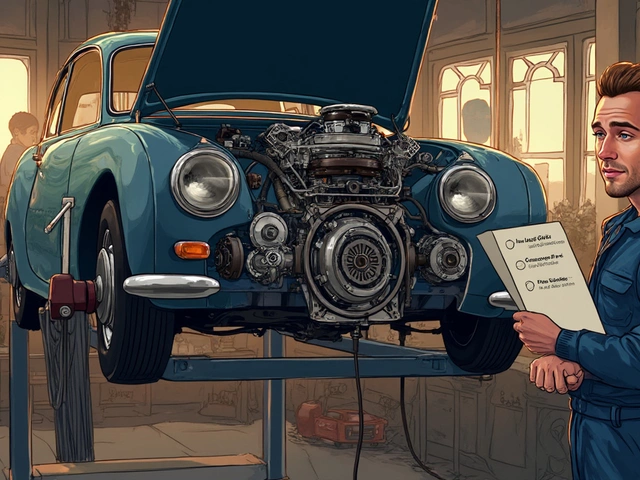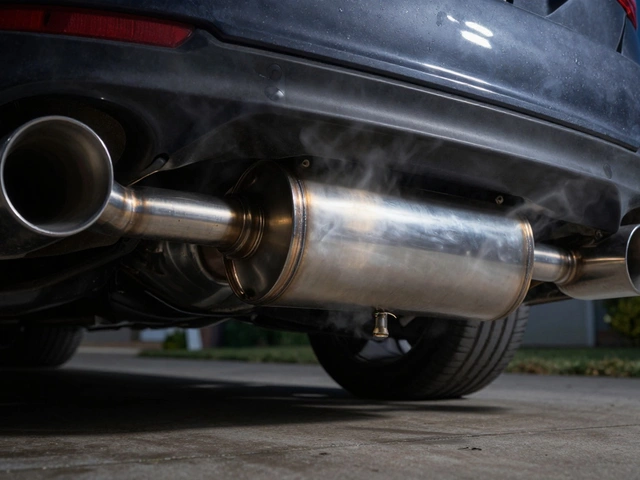The roar of a finely tuned engine is music to an enthusiast's ears, and a well-crafted exhaust system often plays first violin in this orchestra. One might wonder whether a 3-inch exhaust can truly make a difference to your vehicle's performance, sound, and efficiency.
Both veterans and novices in the world of car modification frequently contend with this topic. With many factors to weigh, such as the impact on horsepower, torque, and even fuel economy, settling on exhaust size is as much a science as it is an art. In this discussion, we'll explore why and when a 3-inch exhaust might just be the upgrade you've been searching for.
- Understanding Exhaust Systems
- Benefits of a 3-Inch Exhaust
- Potential Drawbacks and Considerations
- Is a 3-Inch Exhaust Right for You?
Understanding Exhaust Systems
The exhaust system of a vehicle may seem like an afterthought to some, but it's a complex and crucial part of your car's architecture. Let’s dive into what makes it so essential. At its core, the system is responsible for guiding exhaust gases away from the engine and safely out of the car. But that's not all it does. The system also helps reduce the noise produced by those gases as they travel through your car, contributing to a quieter ride and keeping things neighbor-friendly. Additionally, it plays an important role in minimizing harmful emissions, thus doing its part for the environment.
Every engine has its own characteristics, and thus, the exhaust systems tailored for them differ. The components, typically including the manifold, catalytic converter, resonator, and muffler, must work in harmony to achieve optimal performance. The manifold is essentially the collector, directing exhaust gases away from the engine’s multiple cylinders and into one pipe. A significant player here is the catalytic converter, tasked with converting engine pollutants into less harmful emissions before they get released into the atmosphere. However, let's not forget the resonator and muffler, both crucial for sound control. The resonator fine-tunes the noise while the muffler simply keeps it in check.
About 70% of aftermarket exhaust modifications aim to enhance a vehicle's performance and sound. But why do people opt for larger pipes like the 3-inch variety? The idea is that a larger diameter exhaust can improve exhaust flow, which might mean better engine performance, especially in turbocharged or heavily modified engines. Vehicle performance is often about balancing out air intake and exhaust output. A bottleneck in the exhaust restricts your engine from pushing the gas out quickly, thus potentially hampering the inflow of fresh air needed for the next combustion cycle.
According to car enthusiasts and mechanics alike, such modifications can bring about tangible improvements. Robert Hennessey, a renowned automotive engineer, once said,
“A well-designed exhaust system is not just about raw power; it's about creating the right conditions for your engine to breathe efficiently.”He suggests that the right exhaust configuration can mean a difference in how your car feels during acceleration and even how it consumes fuel. Yet, it’s not just about bolting on the biggest pipes you can find. Contemporary cars often have computer-synchronized components, and oversized exhausts could disrupt this delicate harmony, particularly if not properly tuned.
Let's explore some numbers. A typical 2.5-inch exhaust may suffice for engines pushing around 250-300 horsepower. However, once you exceed that threshold, that's where the 3-inch exhausts start to shine. While discussing exhaust systems, it's important to recognize that upgrading might require modifications to other parts, such as headers or ECU tuning, to truly achieve gains in horsepower and torque. This dimensional variance brings about a slew of factors to consider before undertaking any modifications. Ultimately, it's a dance of mechanics, performance, aesthetics, and sound—all tailored to suit the driver’s needs. And that, dear reader, is why understanding exhaust systems is not just about knowing, but about experiencing the symphony of engineering and passion on the open road.

Benefits of a 3-Inch Exhaust
Many car enthusiasts gravitate towards upgrading their exhaust systems, seeking a boost in their vehicle's potential. One such popular modification is swapping out the standard exhaust for a 3-inch exhaust. But the question remains: what are the tangible benefits of this change?
Firstly, a 3-inch exhaust system may significantly enhance the flow of exhaust gases. Larger diameter pipes reduce the back pressure within the system. When back pressure is minimized, your engine can perform at its best. This is because it can expel exhaust gases more freely, unchaining some hidden power and allowing for improved horsepower and torque, which excites those who crave performance.
Additionally, a larger exhaust system can create a distinct and more aggressive sound profile for your vehicle, adding to the aesthetic appeal for many. The deep growl or rich tone emulates the power within and captivates attention on the road. Many drivers find this auditory enhancement a pleasing accompaniment to their driving experience, heightening the perception of speed and power.
Fuel efficiency is another aspect where a 3-inch exhaust might make a difference. With less energy used to push exhaust gases out of the engine, there's potential for a slight increase in efficiency. This depends on driving habits and other modifications, but it seems that the benefits go beyond just power.
"Vehicle exhaust systems are a work of art and science. When executed correctly, they unleash untapped potential in performance," notes an Auto Express expert.For those seeking to tune their engines, a 3-inch exhaust offers a level of adaptability crucial for maximizing performance. It allows for better integration of advanced components such as turbochargers or tuners. These components can exploit the improved exhaust flow to their fullest potential, magnifying both power and driving pleasure.
Finally, the durability of a 3-inch exhaust often surpasses standard smaller systems. Made from robust materials and engineered to withstand higher power, these systems typically boast a longer lifespan. Faulty factory exhaust parts and constant upgrades become less of a worry when you've installed a reliable system designed to perform.

Potential Drawbacks and Considerations
When considering the switch to a 3-inch exhaust, it's not all about immediate gains; this change can present some significant challenges. While enthusiasts often praise the improved performance and deeper sound, a larger exhaust isn't without its caveats. The initial expense can be a hefty commitment, especially when compared to more modest options, with the cost of parts and professional installation often surprising even the most prepared. However, it's essential to weigh these costs against the benefits you expect. The improvement in your vehicle's capabilities might make it worth every penny. Yet, if cost is a primary concern, it might deter those hesitant about investing in their vehicle's modification.
Another factor to consider is the possible decrease in low-end torque; some vehicles might experience a slight dip in power at lower RPMs. This is often attributed to the change in backpressure, which is not always a desired trait for vehicles used in daily commuting or urban environments. Additionally, the significantly larger piping can occasionally mean difficulties fitting within the confines of the car's underbody, potentially leading to unwanted contact with other components or the ground.
Noise is also a crucial consideration. A 3-inch exhaust will undoubtedly make the car louder, and though many enthusiasts find this appealing, it might not be suitable for everyone. The increase in volume can lead to unwanted attention or discomfort during long drives. Residential areas with strict noise regulations could become problematic, potentially leading to fines or failed inspections if the vehicle's noise output surpasses legal limits. Interestingly, some studies suggest that excessive in-cabin noise might contribute to driver fatigue over extended periods.
The potential for increased fuel consumption is plausible with a larger exhaust, particularly if the vehicle isn't tuned to optimize this new component effectively. A mismatch between the exhaust and the vehicle's engine can result in suboptimal fuel-air mixture, leading to more frequent stops at the gas station. It's a common misconception that a performance upgrade automatically results in efficiency; many enthusiasts need to recalibrate their cars to reach the perfect balance.
A quote from automotive expert John Davis sums it up well:
"Performance upgrades should complement each other. A well-chosen size for your exhaust can enhance both power and efficiency side by side. But overlook tuning and it’s like running a race in the wrong shoes."Before diving into the installation of a larger exhaust system, it's essential to assess the specific needs of your vehicle and how you use it daily. It's not merely about bigger equals better; it's about matching your vehicle's performance characteristics and your personal driving habits.

Is a 3-Inch Exhaust Right for You?
Deciding whether to upgrade to a 3-inch exhaust system isn't just about numbers; it requires understanding the specific needs of your vehicle and your driving style. For those who prioritize maximum output and efficiency, especially drivers with vehicles already equipped with turbochargers or superchargers, a 3-inch exhaust can make a noticeable difference. This size allows for better expulsion of exhaust gases, reducing backpressure and potentially improving horsepower. It's crucial to align the choice with the vehicle's engine size and power output. Performance users often find that this increase in diameter provides a freer-flowing system, enhancing both power and torque, particularly at higher RPMs, which can make your car feel significantly more responsive.
Yet, it’s not all about power gains. The auditory excitement that a 3-inch exhaust brings can't be understated. Many enthusiasts seek not just performance but also a deeper, more resonant tone as they accelerate, something quite achievable with a larger exhaust system. However, the sound isn’t merely for show—its low rumble can also act as a warning to other drivers and pedestrians, promoting greater road safety. It's worth noting from experience that some users might find the sound a bit intrusive in a daily driving scenario, especially on long highway cruises.
"The right exhaust can both enhance the performance of your vehicle and reflect the identity you wish to express on the road," says Michael Rolands, a well-known automotive engineer.
One must also consider the legal aspects. Depending on where you live, installing a 3-inch exhaust might lead you into issues with noise regulations, potentially necessitating additional modifications to keep your vehicle street-legal. Researching local laws before making such changes can save you both time and fines. Additionally, consider the cost. The parts and installation of a 3-inch exhaust can be expensive, especially for those seeking high-quality materials like stainless steel or titanium to avoid issues like rust or corrosion.
If fuel efficiency tops your list of priorities, you might harbor doubts. Generally, larger exhaust systems are favored by drivers who lean toward performance over economy. While high-performance setups can slightly optimize engine efficiency, the boost in fuel consumption while pushing the engine hard could offset these benefits. It's best to weigh the emotional satisfaction of a performance upgrade against any potential increase in fuel bills. Make no mistake, the distinction lies in what you desire from your car. Familiarizing yourself with these dynamics stands as a crucial step in getting the most value out of your upgrade plans.








